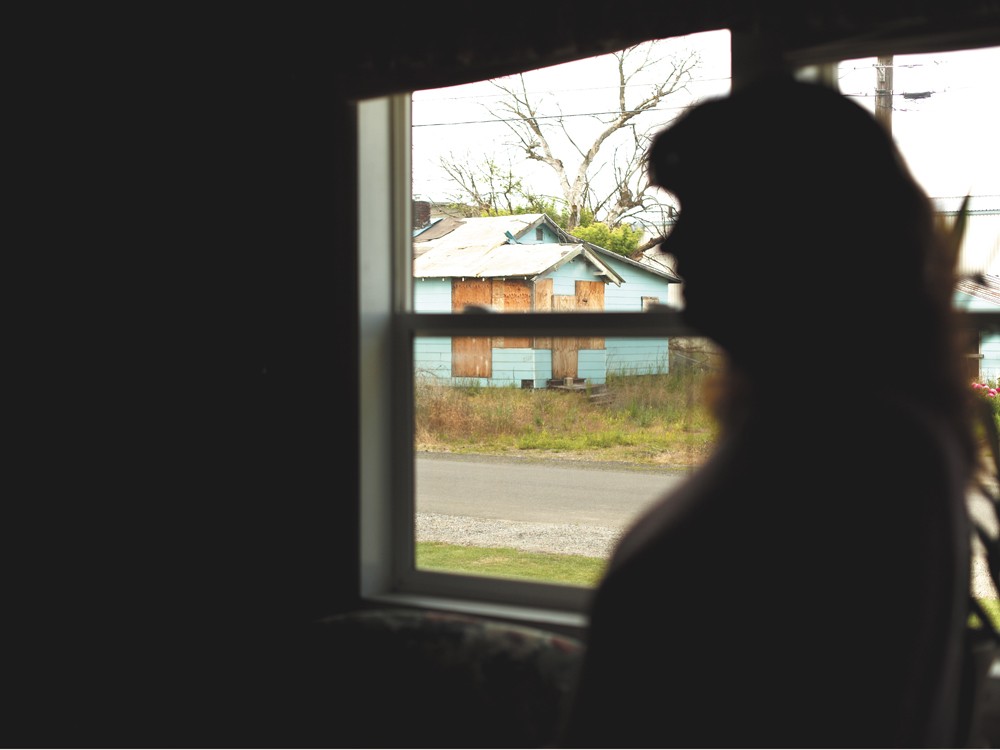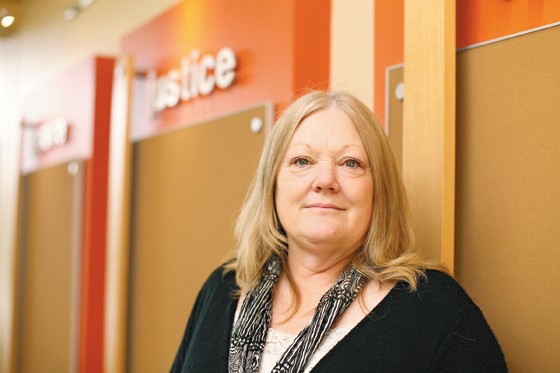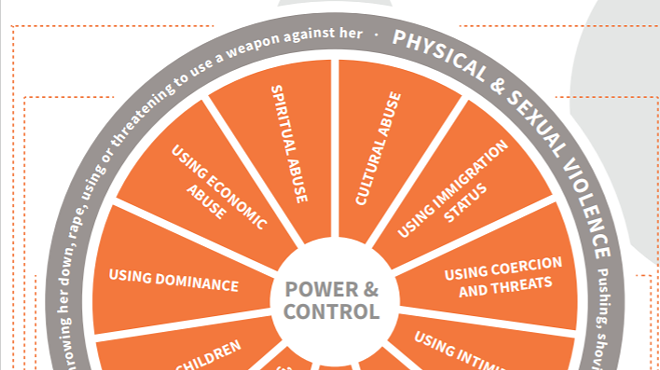Even inside her Spokane Valley home, with a security camera turned on, Traci doesn’t feel safe. She avoids the windows at night, knowing that he might be outside again, standing in the shadows, watching. One day she counted the number of times he called and texted her phone: 42. His messages haunt her.
“By the way, I have a key to the house,” he said in a text. “Want me to tell you how I got it?”
Traci, a former medical assistant, says she’s tried to be reasonable with her ex-husband. Through their parenting plan, he is still allowed to visit their 7-year-old son. Yet on several occasions the boy has returned home with a message from his father.
“He told me, ‘Daddy is going to kill Mommy,” recalls Traci, speaking on the condition her last name not be published. “He said, ‘Daddy was going to bash Mommy’s head in with a hammer, stab her and blow off her head.’”
Traci has called the cops at least 17 times, reporting that her ex, Kale Holten, has broken into her house, destroyed property, stalked and threatened her, records show. She also filed for protection orders, which stated that he couldn’t be within two blocks of her or have any contact with her by phone, email or through other people.
But Traci still doesn’t feel safe. Holten has twice been found guilty of violating the protection orders. He’s spent two days in jail and paid the courts $86, records show. Holten’s attorney declined to comment for this article.
“Every time I go to court, the judge says, ‘The next time anything happens, if you even so much as drive by her house and we find out about it, you will go to jail,’” Traci says. “But he doesn’t. He knows he can get away with it.
“The more he gets away with, the bolder her gets,” she adds.
One in four women in the United States has been the victim of severe physical violence by a boyfriend or husband, according to the Centers for Disease Control and Prevention. It’s the most common 911 call that Spokane Police receive — amounting last year to more than 6,700 calls for that agency alone. And the numbers, year after year, keep growing.
It’s a complicated problem with no easy solution. Police say they’re making arrests as required by law, but they can only do so much. Victims’ advocates point to the courts, saying they give too many chances to offenders. Judges and prosecutors say they’re following the law, but also have to respect the rights of the accused abusers.
Meanwhile, examples abound in which local women have been murdered by the men they had tried to escape.
- Rebecca Schiering of Spokane Valley broke up with her fiancée in 2010 after a domestic dispute. About two months later, he shot and killed her and her 9-year-old-son, and attempted to slit the throat of Schiering’s 17-year-old son.
- Becky Brosnan of Spokane obtained a non-contact order two months after she and her husband were married in 1997, claiming he destroyed her property, choked her, verbally abused her and isolated her from friends and family, according to records. The couple was going through a yearlong divorce and custody battle over their children in 2009 when he beat her to death with a hammer and a metal rod.
- Michelle Canino of north Spokane was stabbed to death by her husband, Jeffrey Canino, in 2009. Her 11-year-old son watched the attack. According to court documents, he told their son he stabbed Canino because she wanted a divorce.
“I’m just outraged at our state, local politicians and policy makers all the way down,” says Patty Wheeler, director of programs at the YWCA. “The violence and potential for violence is not taken seriously in our courts. Budget cuts are decreasing our ability to serve.
“All of this is snowballing down on people who have no way to survive.”
‘A GOOD WIFE’
It was Valentine’s Day. Traci, then a 40-year-old single mother, had just put her three children to bed. She wanted to meet someone, but the bar scene wasn’t a good fit. Online dating wasn’t common yet, so she called a telephone dating service and created her two-minute profile.
“Hey, I’m a country girl. I don’t need a man,” Traci recalls saying. “I’m perfectly OK on my own. I’m just looking for some companionship.”
That night, in 2004, Holten called her. He was charming and made Valentine’s a little sweeter. They chatted for a month before agreeing to meet at a sports bar in Spokane Valley.
But when Holten walked in, Traci left without introducing herself. She says something about him scared her. “I got this gut feeling that I should leave,” she says. “I should have followed my gut feeling.”
But he asked to meet up again, and she agreed. They met at a bar on East Trent Avenue where Traci sang karaoke. Holten said all the right things, Traci recalls. He was a single mother’s dream. He helped around the house and helped shuttle Traci’s children back and forth from school and sports.
Their courtship was brief, and later that year, Holten moved into Traci’s house. But soon, she says, he started to drink all night and sleep all day. He took the children’s allowance money and, during one argument, punched the wall next to Traci’s head. Within less than a year of dating, she kicked him out. Then she discovered she was pregnant.
Their son was born on Feb. 25, 2005, and by August they were married. But the couple would break up in July 2007 after arguing about finances. Traci had grown scared of Holten, so she obtained a domestic violence protection order prohibiting contact.
It had little effect, she says. She would later complain to law enforcement that he broke into the house. And slashed tires. And called her all the time. Then on Thanksgiving, he showed up on her doorstep, asking for forgiveness.
“I never trusted him again, but I felt like I had to give it one last try,” she says. “You got to keep your family together at all costs, you know? I tried to do all the things a good wife should do.”
The calm wouldn’t last. In December 2009, Holten called the police during an ugly altercation. Cops arrested Holten for violating the 2007 protection order. He pleaded guilty and paid the courts a fine of $43.
She got another protection order in 2010. Within the next year, Holten violated it, paying another $43.
“I’d take the kids to the park and come home and my doors would be open,” she says. “I’d look out my sliding glass doors at night and wonder: Is he out there?”
Later this month, Holten will be in court again. Prosecutors have filed charges against Holten alleging that he violated protection orders filed by Traci and another woman. If convicted of the felony charges, Holten could face up to five years in jail and a $10,000 fine.
Traci holds out hope that something will be done, but those charges have been pending since last year, and she’s had to live in limbo in the meantime.
“I’m just disgusted by the whole thing,” Traci says, thumbing through a more-than-a-foot-high stack of police reports and court documents. “I understand the court system has its checks and balances, but this has gone on long enough.”
Traci’s not the first woman who has sought protection from Holten. In 1997, Holten rammed the back of a car carrying his ex-wife and two other people, forcing them off the road. He was sentenced to 29 months in jail, according to records.
His ex-wife obtained a no-contact order from the court, but the next year Holten showed up at her house. When she refused to let him in, he threw a “boulder” through her bedroom window, and another one through her sliding glass door, records state. He was sentenced to 26 months in jail and sent to a domestic violence perpetrator treatment program.
But in 1999, he violated the no-contact order again. He spent two days in jail and his treatment program was suspended.
More recently, he’s been accused of stalking a third woman. According to court records, Holten and a new girlfriend separated in January. Since the breakup that woman’s accused him of watching the entrance of her place of employment, breaking into her house, stalking her daughter and sending threats.
In March, she obtained a one-year protection order against Holten. The woman’s daughter also got an anti-harassment protection order against him.
While researching her own cases, Traci has discovered Holten's criminal history. She can only shake her head. The pattern is so clear now. An ex-wife. Her. A new girlfriend. The girlfriend’s daughter. And yet Holten is still a free man.
“The thing that bothers me the most is I know he won’t stop,” she says. “I’m afraid of what might happen to other women.”
FIRST RESPONDERS
Spokane County Sheriff Ozzie Knezovich relates the same tale often. The story describes “what domestic violence really looks like,” he says.
“Domestic violence is when you pull up to the house and you see Christmas presents and the tree in the front yard,” Knezovich says. “You see the door askew off the hinges. You walk in, there’s blood splattered all over the wall, and there’s a female curled up in the fetal position on the couch crying.
“You turn the corner and there’s a little girl with the biggest brown eyes you’ve ever seen asking why Daddy hit Mommy.”
Domestic violence is the most common call the Spokane Police Department responds to. For Knezovich’s agency, domestic violence is second only to traffic incidents.
“Domestic violence is still that dirty little crime that no one wants to talk about,” Knezovich says.
Washington is a mandatory-arrest state, meaning that when an officer responds to a domestic violence call and has probable cause to believe a crime has been committed within the last four hours, an arrest must be made. In Idaho, unless physical assault, battery, stalking or violation of a protection order occurs, an arrest is made at the officer’s discretion.
But Knezovich says budgets have lowered the number of law enforcement officers on the streets and impacted their ability to respond.
“My concern is that the safety nets are rapidly being stripped away with funding,” he says. “As safety nets slip away, it will increase the number of calls, and number of violent calls we respond to.”
He acknowledges that jailing abusers again and again isn’t treating the problem. But when he looks at his jail facilities, 80 percent of inmates charged with a crime against a person are facing domestic violence offenses.
“We are the first responders,” Knezovich says. “That’s when the system starts kicking in. But there are times that people are out [of jail] before the deputy’s reports are done. We’re working very diligently to try and fix the criminal justice system, but as resources get taxed, all these dynamics feed into a never-ending cycle.
“How do you keep perpetrators off the street when the system is not handling that task?” the sheriff asks.
In 2010, the Washington State Coalition Against Domestic Violence released a report examining domestic violence-related murders committed in the state in the past 13 years. Panels made up of judges, lawyers and advocates analyzed 135 separate cases (only a portion of the 755 related homicides during that period).
“One of the things we noted was a lack of consistent response and follow-up within the legal system,” says Jake Fawcett, lead researcher on the study.
Of the 135 murders they reviewed, the panelists found that authorities had documented 157 related incidents of domestic violence. Yet only five abusers spent more than 30 days in jail. Fewer than half of the incidents resulted in the abuser’s arrest, and only 4 percent of abusers actually completed their full sentence.
The report concludes that courts failed to address victims’ safety, minimize patterns of domination, impose meaningful consequences or intervention for abusers and offer sufficient post-sentencing supervision.
“We saw a million different ways where people tried to get safe,” Fawcett says. “The common denominator was that when people reached out for help, the supports weren’t there.”
The support system in Spokane is under pressure. Requests for help have increased by 21 percent over the last two years, says Wheeler, of the YWCA, which runs the Alternatives to Domestic Violence program.
“The increase doesn’t mean that more violence is occurring,” Wheeler says. “It means that these women have no other place to turn.
“If we can’t provide shelter, if we can’t provide counseling, transitional housing and legal aid, women won’t be able to get out of their situations and we are going to have more major crimes.”
Wheeler says budget cuts are also crippling their ability to serve. Funding from the city and county for the Alternatives to Domestic Violence was cut by 76 percent in 2010. The impact, she says, is seen everywhere.
“The police are doing all this arresting and getting people into the system but nothing happens,” Wheeler says. “Jail becomes a revolving door because there are mandatory arrest laws, but there aren’t mandatory consequences.”
Wheeler says prosecution is overwhelmed with cases. Unless the allegations are egregious, many abusers are arrested and released within a 24-hour period without consequences, she says.
“You have to treat aggressors swiftly,” she says. “Not when it’s their 10th time in court. Victims need the court telling their abusers that their behavior was wrong. Aggressors need to know they can’t get away with it.”
A COURT, DIVIDED
In 1997, the city received a $1.6 million grant from the Justice Department to create one of the nation’s first specialized domestic violence courts.
Superior Court Judge Annette Plese helped organize the court. Today, her judges chambers look like an old-fashioned library, where books are neatly stacked, floor to ceiling.
“We were truly innovative and moving forward,” Plese says. “I truly believed we were going to make some changes instead of just jailing and punishing people. We wanted to stop people from coming back in the system.”
Plese says the goal of the court was to give specialized attention to domestic violence cases by placing the same prosecutors, public defenders, probation officers and judges on the same cases — regardless of city and county jurisdictions. They hoped that specialized treatment and standardized responses would hold offenders accountable.
Judges required perpetrators to be evaluated and receive domestic violence perpetrator treatment. The judges held treatment reviews, which required offenders to not only check in with probation officers, but also with judges themselves.
The city and county continued to support the court after federal monies ran out, but then something happened at the end of 2008. Two men convicted of misdemeanor DUI won an appeal on the argument that the county’s District Court didn’t have jurisdiction over misdemeanors within the city limits.
Rather than fight the ruling, or attempt to have state law rewritten, the city decided to establish its own Municipal Court to handle misdemeanors.
Plese, then-Mayor Mary Verner and city officials discussed maintaining the domestic violence court, but in the end it was dismantled.
“It was very depressing when the city pulled out,” Plese says. “Financially, I think they thought they could do it better, cheaper and have more control ... but it seems like we’ve gone backwards.”
As a result of the split, misdemeanor domestic violence cases are handled separately depending whether the cases originated in the city or other parts of the county. Now, three judges handle domestic violence cases in Municipal Court, and one handles cases in District Court.
Plese says it’s now not uncommon for offenders to have two public defenders, two prosecuting attorneys, two judges, two probation officers and multiple protection orders and sentences on multiple cases.
“Now attorneys and judges are looking at their cases in a little tunnel of either a city or county case and not seeing the big picture,” Plese says.
Attorneys and judges working in Municipal Court say blame is wrongly being directed at them. They say the loss of the specialized court hasn’t affected their ability to protect victims and hold offenders accountable.
Nevertheless, domestic violence case filings for the city have increased by 50 percent since Municipal Court was formed in 2009, says Mike Reinken, chief assistant for the Spokane City Prosecutor’s Office.
“I don’t think the court expected the volume of domestic violence cases we’re seeing,” Reinken says. “I’m not saying the volume increase we’re seeing is because of the split. I think it’s increasing because of the economy and the added tension on families as a result of the economy.”
He says prosecutors do continue to communicate with their counterparts across jurisdictions.
“Within the constraints that we are currently working, we are still emphasizing domestic violence cases in our office,” Reinken says. “There is some normal fallout from budget cuts, a poor economy and lack of funding in general, but given the increased volume we have experienced lately, we do a pretty fantastic job of prosecuting domestic violence cases.”
Municipal Court Judge Mary Logan says she and her fellow judges treat the crime no differently on the bench. She says she understands that victims’ advocates are frustrated, but says everyone has their role to play in the criminal justice system.
“We cannot be in the role of advocates for anybody. We are in the role of advocates for public safety,” Logan says. “But that’s a big label that gets diluted in the process because really, we are just trying to have a very neutral court setting where people can come in and experience justice.”
Logan says Municipal Court tries to treat cases just as they would have been when the domestic violence court existed. She adds that allocating cases to three separate judges, instead of one, allows them to be more sensitive to each case.
The Municipal Court has decided, though, not to order treatment as often as before. Logan says perpetrator treatment has not been persuasively proven to change recidivism rates.
She raised the issue and her concerns with local treatment providers last year, she says.
“Why would I, in good conscience, just accept treatment that hasn’t been proven to work?” she says. “We are really trying to engage in evidence-based sentencing to create change on every single case. There should be no expectation of a cookie-cutter approach to any of these cases.”
Treatment providers say it’s clear that fewer offenders are now being sent to perpetrator treatment. And of those who are sent, providers estimate that less than 20 percent complete their full treatment program.
Penalties for offenders who violated the conditions of their sentence have also been weakened, say treatment providers.
Bonnie Scott, director of Social Treatment Opportunity Programs (STOP), says probation departments regularly file non-compliance reports to the court but sanctions are rarely imposed. It’s even rarer, she says, that offenders are reinstated back into treatment.
Scott points to the files stacked almost two feet high on her office floor. Each file represents an abuser who has not completed his court-ordered treatment.
“People don’t understand that these women live in terror,” she says. “They are not just abused but terrorized. They never know what mood he’s going to come home in. It’s a constant battle just to get dinner on the table and the kids in bed without a fight. It’s like living in a war zone.”
Yet Scott says the majority of batterers can be helped.
“Right now I’m allowed to do about an eighth of my job because I don’t have the backing of the legal system,” she says. “Instead of saying, ‘Hey let’s get this guy some help so he doesn’t end up in a murder-suicide setting,’ they are suspending treatment or not issuing it at all.”
NO LACK OF WARNING
Law enforcement was familiar with 28-year-old Veniamin Gorkovchenko long before they were called to an apartment on East Fifth Avenue on Oct. 10.
There they found Gorkovchenko dead on the front lawn in a pool of blood. He had shot himself in the right temple. Next to him was a .22-caliber shell and a still burning, half-smoked Marlboro cigarette.
Upstairs, officers found Gorkovchenko’s ex-girlfriend on a couch by a window, blood streaming down her head, neck and chest. At the center of her forehead, near the hairline, was a bullet hole. She was alive.
“Help me, I’ve been shot. I’ve been shot,” she told officers. “My ex-boyfriend shot me, he came in here and shot me.”
Paramedics lifted the 21-year-old woman on a gurney. They carried her down the narrow stairwell and into an ambulance headed to Sacred Heart Medical Hospital. In the ambulance on the way there, she said Gorkovchenko had a handgun and was “pointing it at me and then I heard it go off.”
Gorkovchenko had pushed his way into the apartment on East Fifth, where his ex had stayed the night visiting friends, according to police reports. Another woman in the apartment confronted Gorkovchenko, and he put the gun to her forehead and asked, “Are you ready to die?”
Screaming, crying, in English and Russian, Gorkovchenko then confronted his ex: “Why did you leave me?”
He pointed the gun at her. She shouted back, saying she didn’t need him anymore and that he was a woman hater.
Then she heard a boom. Everything went fuzzy. She knew she had been shot.
The bullet, she would later learn, had cracked her skull, and bullet fragments had wedged themselves in the fracture, but didn’t enter the brain cavity. She would make a full recovery.
The Inlander met with the woman for this article, but she declined to be interviewed. The following account comes from police reports.
She started dating Gorkovchenko in May 2009, and soon, she says, he became possessive. One day that year, while she and a friend chatted in a car, Gorkovchenko arrived angry and began arguing with her.
He walked to his car and came back with a small pickaxe — a tool with a wooden handle and an axe on one end and a hammer on the other. He shouted at her friend: “Bitch, do you want to see this down your throat?”
When the woman tried to intervene, Gorkovchenko swung the axe at the car, hitting the center of the driver side hubcap. The woman told the responding police officer that Gorkovchenko “probably wouldn’t hurt me,” but she thought he was going to strike her friend with the axe.
Gorkovchenko was arrested and charged with domestic violence-related malicious mischief and the judge issued a no-contact order to protect Gorkovchenko’s ex-girlfriend. He got out of jail the next day.
A month later he was arrested again and charged with violating the order. Again, he got out of the jail the next day.
Gorkovchenko’s defense attorney said he would volunteer to attend a 24-hour domestic violence perpetrator treatment program at STOP counseling services in Spokane.
Bonnie Scott, director of the program, denied Gorkovchenko’s entrance into the program after an hour-long evaluation. She says he was too violent for a 24-hour program and recommended instead that he complete a full domestic violence perpetrator treatment program, which would take one to two years.
Scott sent the evaluation and denial to the program to his ex-girlfriend and his public defender.
“He would be alive and she wouldn’t have a bullet in her head if he would have had to follow through with treatment,” Scott says. “But nobody made him. They just let him go.”
His case was continued three more times. He failed to show up for court twice, was arrested and then, in 2010, he entered into a 24-month stipulated “order of continuance,” which is a contractual agreement and probation period with the court. The no-contact order was dropped. Domestic violence perpetrator treatment was suspended.
Two months later, Gorkovchenko got drunk and kicked a 12-inch hole through his parents' living room wall. He walked off while his mother ran across the street and asked the neighbor to call the cops.
In 2011, a year after the incident, the Office of the Spokane City Prosecutor filed domestic violence-related malicious mischief charges against Gorkovchenko because of the incident with his parents. This case was also continued three times, until eventually the prosecutor dropped the charges.
Donna McBride, chief probation officer for the City of Spokane, remembers Gorkovchenko well.
“Oh, I know exactly who this is,” she says. “This is the attempted murder-suicide. This is everyone’s worst nightmare.”
On June 23, 2010, the probation department sent a letter to prosecutors reporting that, because Gorkovchenko had been charged with trespassing, he had violated his probation.
On January 26, 2011, the probation department sent a letter to prosecutors reporting that Gorkovchenko had violated his probation — again.
“The prosecutors saw both violations but chose not to proceed,” McBride says.
Less than a year later, he would shoot himself and his ex-girlfriend.
LIFE ON HOLD
Traci’s coffee table is covered with her son’s LEGOs. On the floral print couch are his crayon drawings of circles and stars.
Traci wrings her hands when talking about the boy’s father. She has chocolate brown eyes and waves of hazelnut hair. She sips coffee from a mug covered in jokes about menopause in her Spokane Valley home, and flips through the petitions and the police reports she’s filed against Holten, her ex-husband.
She waits for resolution in the courtroom and has prepared her evidence and statement for Holten’s felony trial, scheduled for next month.
She isn’t ashamed of the choices she has made and the chances she gave Holten. She simply wishes the court hadn’t given him so many chances. She wishes the courts would have protected her when she didn’t have the strength to do so herself.
At home she points to the “beware of dog” sign on her garage door and the motion detector lights at the front of the house. Across the street, waist-high weeds engulf the teal-colored abandoned house where she says Holten used to sit at night and watch her.
Plywood now covers the broken windows. Traci boarded up some of the windows herself.
“I used to be afraid of my own shadow,” she says. “I didn’t know what I was doing. All victims ever do is wonder what they did wrong.”
GET HELP
If you or someone you know needs help, call the Alternatives to Domestic Violence 24-hour hotline at (509) 326-2255. In Idaho, call the North Idaho Violence Prevention Center at (208) 664-9303. There is also the National Domestic Violence Hotline at (800) 799-7233.
57
People in Washington were killed by their abusers in 2011, up from 50 the year before, according to the Washington Association of Sheriffs and Police Chiefs. In Idaho, 22 people were killed by their abusers in 2011, up from 13 the year before, according to the Idaho Coalition Against Domestic Violence.
In Olympia: Adding Protections
In March, the state Legislature approved progressive domestic violence legislation. Rep. Roger Goodman, D-Kirkland, sponsored a bill that provides increased protections for victims who risk being stalked by their abusers and stiffens penalties for violating domestic violence no-contact orders.
“Domestic violence is a chronic problem and nobody wants to talk about it,” Goodman says. “Not in the Legislature, not in the media, not in polite society. Nobody wants to step up to the plate. … This is a societal problem that can only be addressed through cultural change. The Legislature can only respond after it’s happened. Society must wake up to the issue.”
— JORDY BYRD
IDAHO: ONE FAMILY, ONE JUDGE
Domestic violence courts operate in five judicial districts in Idaho. One judge handles all criminal domestic violence cases and related family issues such as divorce, custody and civil protection orders. Idaho’s domestic violence courts accelerate the disposition of criminal domestic violence cases resulting in offenders entering treatment earlier. Offenders also receive on-going judicial review hearings to ensure immediate consequences for non-compliance.
According to the Idaho Supreme Court, since the inception of Idaho’s domestic violence courts in 2006, Idaho has seen a 23 percent decrease in violations of criminal no-contact orders and civil protection order charges and a 14 percent decrease in criminal misdemeanor and felony domestic assault and battery charges filed with the court.





















